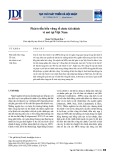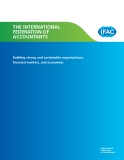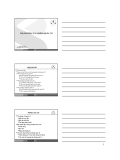
VNU Journal of Economics and Business, Vol. 4, No. 2 (2024) 80-91
80
Original Article
Global bank linkages and foreign direct investment
Tran Manh Ha*, Doan Ngoc Thang
Banking Academy of Vietnam
No. 12 Chua Boc Street, Dong Da District, Hanoi, Vietnam
Received: January 29, 2024
Revised: March 29, 2024; Accepted: April 25, 2024
Abstract: This study explores the impact of bank networks on foreign direct investment (FDI) using
data on country pairs. Global bank linkages are quantified by the number of connected bank pairs
engaged in international lending between the source and host countries. The empirical analysis
reveals a positive correlation between bank linkages and bilateral FDI stocks. We interpret this
relationship as indicating that bank connections facilitate FDI by addressing information asymmetry
stemming from factors such as uncertainty, global financial crises, or host country shocks. Our
findings remain robust across various robustness checks. This research suggests that governments
should promote cross-border bank investments to attract FDI.
Keywords: International banking; foreign direct investment; uncertainty.
1. Introduction*
There is a growing consensus on
international banking and its role in facilitating
FDI. Banks can internationalize by forming
foreign branches, acquiring foreign subsidiaries,
purchasing foreign assets, or lending across
countries directly. When the loans are large, they
can also make foreign syndicated lending via
bank consortiums to share risk. When expanding
overseas through FDI, firms face fixed costs
caused by information asymmetry (Antràs et al.,
2009; Han et at., 2022). We argue that an
international network of banks can mitigate
these costs by alleviating the information
asymmetry. Hence, the purpose of this paper is
________
* Corresponding author
E-mail address: hatm@hvnh.edu.vn
https://doi.org/10.57110/vnujeb.v2i6.257
Copyright © 2024 The author(s)
Licensing: This article is published under a CC BY-NC
4.0 license.
to examine the effect of bank linkages on
outward FDI.
Bank connections play a crucial role in
reducing the fixed expenses associated with FDI
through various mechanisms e.g. by bridging the
institutional disparities between the home and
host countries (Poelhekke, 2015). Furthermore,
banks offer advantages to parent companies by
specializing in the gathering and management of
information concerning the businesses they lend
to. Typically, these lending relationships
between banks and firms endure over extended
periods. The symbiotic relationship between
banks and firms enables banks to utilize informal
information, giving them a competitive edge
(Boot, 2000). This implies that banks possess
.
VNU Journal of Economics and Business
Journal homepage: https://jeb.ueb.edu.vn

T.M. Ha, D.N. Thang / VNU Journal of Economics and Business, Vol. 4, No. 2 (2024) 80-91
81
comprehensive insights into their clients, their
operational dynamics, and opportunities for
overseas investments. Leveraging this
knowledge, banks facilitate firms seeking
expansion abroad by offering financial and legal
support through an interconnected network of
banks spanning different countries.
Additionally, bank connections reduce
investment expenses by broadening and
enhancing the pool of potential firms available
(Poelhekke, 2015). Given the risk of failure,
parent companies must identify reliable partners.
The associated search costs necessitate financial
intermediaries (Beck, 2002). Host-country
banks, with their domestic presence, can discern
reputable firms by exclusively engaging with
financially robust entities. This proprietary
knowledge can be exchanged within a network
of affiliated banks. Augmenting the number of
bank connections enlarges the roster of
dependable firms, thus diminishing search costs.
Lastly, bank nexuses improve the internal
financial organization of multinational
enterprises. As international banks have
knowledge about the parent firms’ businesses
and host-country imperfections in external
capital markets, they can provide an efficient
plan to organize financing for both the parent and
FDI firms and help to fundraise in various
financial markets. Moreover, banks can arrange
direct financing for multinational enterprises in
the new markets. De la Torre et al. (2010)
indicate that international banks can offer a loan
package with a highly competitive fee for
multinational enterprises’ operations related to
FDI. Klein et al. (2002) document that firms are
reluctant to implement FDI projects when their
home banks suffer financial turmoil.
To investigate the relationship between bank
linkages and FDI, we use bilateral country-year
data, including 1,624 country pairs for the period
2001–2012. We define global bank linkages as
the number of bank pairs that connect via
international syndicated lending from source to
host country. Syndicated loan data is utilized as
these loans can usually be extended to other
banks and thereby create a dense linkage of
banks (Hale, 2012). In addition, the 3-year
median of these loans’ maturity implies that
banks can accumulate rich information
(Poelhekke, 2016). We use the bilateral outward
FDI stock as it is less volatile than bilateral FDI
flow (De Sousa and Lochard, 2011). We add the
year, country, and pair-fixed effects to mitigate
the unobserved variables’ biases. Since we argue
that the global bank linkages may reduce adverse
effects of uncertainty, crisis, and shocks and
adverse effects of distance on financial market
development, culture and geography, the
interaction terms between the global bank
linkage and variables capturing this information
are added into the original model. This paper’s
main finding is that bank linkages have a
positive association with outward FDI because
they help to dampen the adverse effects caused
by uncertainty, crisis, and shocks in the host
country. Our finding implies that to facilitate
outward FDI, governments should support the
formation of bank linkages across countries.
Our paper belongs to several strands of
literature. Firstly, this article is closely related to
papers that investigate an association between
cross-border banking flows and outward FDI.
Although the importance of banking networks in
overcoming home bias in investment is argued
by Hale (2012), the study of Poelhekke (2015)
is the first to provide evidence of this
relationship. By using restricted access data in
The Netherlands covering 19 years (1984–2002)
and 190 host countries, Poelhekke (2015)
demonstrates that FDI by non-financial firms is
boosted by banking foreign investments.
Recently, Donaubauer et al. (2020) highlighted
the essential role of FMD in increasing FDI.
Although there are several studies such as Klein
et al. (2002), and Bilir et al. (2019) raising the
same issue, these papers address FMD on just
one side of the source-host pair. Donaubauer et
al. (2020) and Cerutti et al. (2023) indicate that
an increase in inward and outward FDI is
contingent upon the development of the home
and host countries’ financial markets. Apart
from these studies, there are no others that focus
on explaining the relationship between global
bank linkages and FDI flows.
The second strand of the literature relevant
to this study is related to research on factors that
make FDI costly, and the role of global bank
linkages in mitigating these costs. This role
arises because banks specialize in acquiring and
processing information about their borrowers
(e.g., potential affiliate firms), and they may
therefore provide information advantages to
parent firms. Similar discussions explaining the

T.M. Ha, D.N. Thang / VNU Journal of Economics and Business, Vol. 4, No. 2 (2024) 80-91
82
firm-bank relationship and the information
advantage over other banks obtained from this
relationship can be found in relevant studies
(Boot, 2000). Poelhekke (2015) also argues that
knowledge about banks’ customers and
investment opportunities abroad allows banks to
offer financial and legal advice, thus helping
firms to overcome any difficulties and barriers
between home and host countries.
In the literature, the first factor includes
uncertainty and information asymmetry (Antràs
et al., 2009), or shocks (Goldberg, 2009). Prior
scholars argue that the risk arising from this
factor may lead to a reduction in international
transactions. For example, Beck (2002)
demonstrates that information asymmetry has
great impacts on investment decisions.
Regarding the effects of shocks, Choi and
Furceri (2019) consider financial shocks and
show how they negatively affect international
trade through increased corporate risk. The
adverse effects of other types of shocks such as
natural disasters, terrorist attacks, and
unexpected political shocks are discussed in
Baker and Bloom's (2013) study. Under these
circumstances, cross-border banking flows
promote FDI flows through the information
advantage about host-country firms or by
attenuating the adverse effects of risk arising
from uncertainty and shocks. In particular, the
effects of risk can be reduced in countries with a
greater share of trade finance; thus, there is an
improvement in international transactions
(Niepmann and Schmidt-Eisenlohr, 2017).
Poelhekke (2015) indicates that the impacts of
banking FDI are stronger in countries with great
information asymmetry and hazardous
investment. Goldberg (2009) also concentrates
on the transmission of shocks through
multinational banks and their positive effects on
growth, then implies the nexus between bank
globalization and multinational firms.
Multinational banks are essential for firms
expanding their businesses abroad through FDI,
as they help them to overcome information
asymmetry and foreign market frictions.
The second factor that makes FDI costly is
distance. Petersen and Rajan (2002) contended
that a greater distance causes the effective
collection of information to be harder, which
suggests that banks’ local presence via FDI
through their subsidiaries and branches plays a
more important role than that of cross-border
lending. There are information asymmetry and
higher search costs at greater distances (Guiso et
al., 2009), and they are two of the main reasons
for financial intermediation (Beck, 2002).
However, these issues can be reduced by cross-
border banking investments through the
information advantage about host-country firms
or by attenuating the adverse effects of distance
between the home and host countries, as argued
by Poelhekke (2015).
Although the literature has investigated the
association between global banking investments
and the flows of FDI, and the role of banking
networks in reducing risk and information
asymmetry, there are still gaps in this field. First,
there is a paucity of studies on this relationship.
The sole paper on this subject is Poelhekke
(2015). However, this study only investigates the
effects of banking FDI and non-financial FDI
between one nation (The Netherlands) and 190
host countries. Moreover, home banking FDI is
defined simply as the stock of outward FDI to
the host country by Dutch resident banks. Our
study fills this gap by using country-pair data
around the world to examine the effects of cross-
border bank linkages and bilateral FDI stocks.
Regarding bank linkage, we follow Caballero et
al. (2018) to use cross-border syndicated lending
as a measure for the number of bank pairs in
these two countries. Unlike the cross-border
stocks and flows of outstanding bank claims
based on the BIS database and bank ownership
linkages (Claessens and Horen, 2014), our
measure captures banks’ information acquisition
as it is based on long-term interbank
relationships. Second, to the best of our
knowledge, there has been no paper
investigating the effects of global bank linkages
on reducing the risk and information asymmetry
arising from uncertainty, shocks, and distance, as
this study does. Our paper, therefore, provides a
more in-depth explanation of the mechanisms
through which cross-border bank linkages
promote the flows of FDI.
The rest of this paper is organized as follows:
Section 2 describes the methodology; Section 3
provides the empirical results; Section 4 gives
concluding remarks.

T.M. Ha, D.N. Thang / VNU Journal of Economics and Business, Vol. 4, No. 2 (2024) 80-91
83
2. Data and methodology
We specify the following model to estimate
the effect of bank linkages on FDI1.
𝐹𝐷𝐼𝑖𝑗𝑡 = 𝛽0+ 𝛽1𝐿𝐼𝑁𝐾𝑖𝑗,𝑡−1 +
𝛽2𝐶𝑂𝑁𝑇𝑅𝑂𝐿𝑖𝑗,𝑡−1 + 𝑣𝑡+ 𝜆𝑖+ 𝛾𝑗+ 𝛼𝑖𝑗 + 𝜀𝑖𝑗𝑡, (1)
where superscripts i and j denote the source
and host country, and t denotes year. 𝑣𝑡, 𝜆𝑖, 𝛾𝑗,
and 𝛼𝑖𝑗 capture year, source-country-fixed, host-
country-fixed, and pair-fixed effects,
respectively. LINK measures the aggregate
number of bank linkages of country i in country
j and this is simply the sum of bank pairs in
which banks in country i lend to those in country
j. We rescale LINK by dividing by 100. 𝐹𝐷𝐼𝑖𝑗𝑡
is the bilateral FDI stock of country i in country
j in year t. The FDI is reported in terms of
millions of USD, and we take a natural
logarithm. In this vein, we apply log-
linearization to solve with the zero-trade
problem. Another approach used to solve zero
observation and the presence of
heteroscedasticity is the pseudo-Poisson
maximum-likelihood (PPML) estimation
technique proposed by Silva and Tenreyo
(2006). Yet, Head et al. (2014) and Martin and
Pham (2020) argue against the biased
estimations that derive from using PPML when
there is large zero observation2. CONTROL is a
set of control variables, including GDP,
population, area, and other common gravity
variables that capture weighted distance (D),
colonial relationship (colony), common
colonizer post-1945 (comcol), common
language (comlang), contiguity (contig), and the
same country currently or in the past (smctry).
While GDP represents the economic scale,
physical distance captures the transportation
cost. Other variables reflect the information
costs. We also incorporate multilateral real
exchange rate (REER), financial openness
(KAOPEN), and difference in corporate tax
(Corporatetax).
FDI data is collected from UNCTAD,
while bank linkages are computed based on
syndicated bank loans from Dealogic’s Loan
Analysis3. The value of outward FDI is set to
zero with negative FDI stock reports. GDP,
population, and area are taken from the World
Bank database. The gravity variables are
obtained from CEPII. Data of REER is collected
from Bruegel Datasets. The Chinn-Ito Index is
used to capture financial openness. Corporate tax
is obtained from Tax Foundation.
Table 1: Statistical summary
Variable
Obs
Mean
Std. Dev.
Min
Max
FDI
12,813
6.37
2.79
0.00
13.38
LINK
12,813
0.18
0.49
0.00
6.74
GDPi
12,813
9.37
0.90
6.49
10.69
GDPj
12,813
8.90
1.14
5.61
10.69
contig
12,813
0.06
0.24
0.00
1.00
comlang
12,813
0.10
0.31
0.00
1.00
colony
12,813
0.05
0.21
0.00
1.00
comcol
12,813
0.01
0.07
0.00
1.00
smctry
12,813
0.01
0.10
0.00
1.00
D
12,813
6.24
4.52
0.16
19.56
REERi
12,813
99.72
14.01
40.68
319.74
REERj
12,813
100.77
15.93
40.68
319.74
KAOPENi
12,813
0.81
0.30
0.00
1.00
KAOPENj
12,813
0.77
0.33
0.00
1.00
CorporatetaxD
12,813
1.88
10.38
-45.00
40.87
WUI_Word
12,423
0.78
0.11
0.42
1.26
WUI_Page
12,423
0.77
0.08
0.46
1.13
Stockvol
12,119
-3.10
0.38
-4.23
-1.59
Bankcrisis
12,500
0.04
0.20
0.00
1.00
Debtcrisis
12,500
0.01
0.08
0.00
1.00
________
115% in our sample.
2 We thank Caballero et al. (2018) for sharing the data.

T.M. Ha, D.N. Thang / VNU Journal of Economics and Business, Vol. 4, No. 2 (2024) 80-91
84
Currcrisis
12,500
0.00
0.06
0.00
1.00
natshock
6,535
0.43
0.71
0.00
4.00
revshock
6,535
0.01
0.08
0.00
1.00
tershock
6,535
0.03
0.22
0.00
4.00
Foreignown
3,193
1.97
1.50
1.00
11.00
FDIflow
8,803
4.34
2.75
0.00
11.60
Source: Author’s calculation.
3. Empirical results
3.1. Benchmark results
Columns 1-2 in Table 2 outline the main
benchmark results of equation (1), where we
examine the association between the number of
bank linkages in year t-1 and the FDI stock in
year t. In all models, we cluster standard errors
in country pairs. In Column (1), we include all
common gravity regressors, considering both
country and year fixed effects. Our results show
that LINK is statistically significant at a 1%
level, and it has a positive sign as expected. In
other words, bank linkages positively affect the
following year’s FDI. This finding is aligned
with Poelhekke (2015), who investigates the
relationship between global finance proxied by
so-called “banking FDI” and non-financial FDI.
The positive and significant impacts of GDPi
and GDPj imply that the greater the size of the
source and host countries’ GDP, the simpler it
will be to either make the decision or find an
appropriate destination for investment abroad.
Donaubauer et al. (2020) also investigate the
effect of GDP in the source and host country on
bilateral FDI, but they only find a positive sign
for the effect of income per capita of the origin
country on FDI in developing host countries.
They argue that this fact may stem from the
opposing effects of the horizontal and vertical
FDI. Other common gravity regressors such as
the contiguity (contig), the colonial relationship
(colony), the common language (comlang), the
same country currently or in the past (smctry),
and the bilateral distance (D) also play a vital
decisive role in bilateral FDI. The positive signs
of contig, comlang, and smctry, as well as the
negative sign of D, suggest that the proximity
and share of commons can reduce the risk of
investment failure, thus enhancing the
motivation to make investments abroad.
Petersen and Rajan (2002) also contend that the
physical proximity of lenders and borrowers
plays a vital role in effectively monitoring and
collecting soft information. The coefficients of
financial openness are statistically positive,
implying that a more liberal capital account
boosts the bilateral FDI. We use the difference in
corporate tax rates between source and host
countries as a proxy for excess profit in which
the returns on the FDI host country are larger
than that on the FDI source country. However,
the coefficient of CorporatetaxD is insignificant.
Finally, real exchange rates play no role in
determining FDI linkage.
In the second regression, there is the concern
that the correlation between global bank linkages
and bilateral FDI might result from the
globalization trend or historically established
country ties, so we include the pair country i and
j fixed effects and report the results in Column 2
in Table 2. The results reveal that the variable
LINK is still statistically significant at a 1%
level, but its magnitude slightly decreases. This
discussion is consistent with that of Caballero et
al. (2018).
We additionally assess the impact of control
variables on FDI with and without considering
the influence of bank linkages. Overall, while the
size of coefficients may vary slightly, their
significance levels remain consistent.
Table 2: Baseline results
(1)
(2)
Variables
FDI
FDI
LINK
0.250***
0.193***
(0.0689)
(0.0738)
GDPi
1.233***
1.242***
(0.157)
(0.158)
GDPj
0.558***
0.582***










![Tổng quan về quỹ tiền tệ quốc tế IMF [chuẩn nhất]](https://cdn.tailieu.vn/images/document/thumbnail/2012/20121015/honghien92/135x160/2132242642.jpg)















